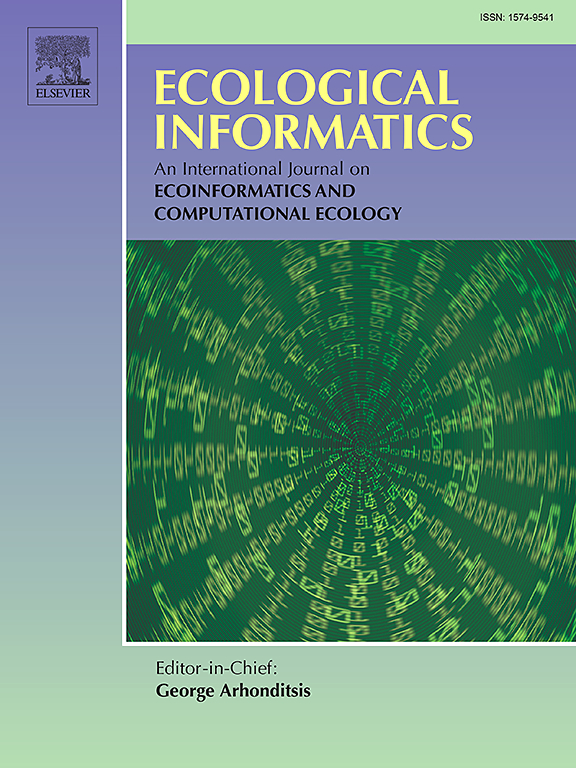Environmental responses and interspecific associations of marine fishes revealed by HMSC: A case study in the offshore waters of southern Zhejiang, China
IF 7.3
2区 环境科学与生态学
Q1 ECOLOGY
引用次数: 0
Abstract
Accurately predicting fish spatial distributions is essential for fisheries management and ecosystem conservation. However, organism-environment relationships are often complex and dynamic. Using summer survey data collected between 2017 and 2023 in the offshore waters of southern Zhejiang, China, we applied Hierarchical Modeling of Species Communities (HMSC) framework to compare five candidate models that differed in environmental variables and the inclusion of a spatial random effect. Model comparison identified the model combining both linear and quadratic terms for seawater temperature, a linear term for salinity, and a spatial random effect as optimal. The result indicates that allowing a nonlinear temperature response and accounting for spatial dependence improved model fitting over the other four specifications. Variance partitioning attributed 59.4 % of the explained variation to the spatial random effect, 35.7 % to temperature, and 4.9 % to salinity, underscoring the dominant role of spatial processes in shaping fish community patterns. After controlling for environmental covariates and spatial structure, residual species associations grouped eight dominant species into two assemblages: (1) small demersal predators, including Harpadon nehereus, Larimichthys polyactis, Atrobucca nibe, and Pennahia argentata; and (2) pelagic species, comprising Decapterus maruadsi, Psenopsis anomala, Trichiurus lepturus, and Pampus echinogaster. Species within the same assemblage showed significant positive residual correlations, whereas correlations between assemblages were generally moderate to strongly negative, revealing contrasting habitat use and trophic niches. These findings provide a scientific basis to support fisheries management, the assessment of stock enhancement programs, and ecosystem conservation in the offshore waters of southern Zhejiang.
HMSC揭示的海洋鱼类的环境响应和种间关联——以浙江南部近海为例
准确预测鱼类空间分布对渔业管理和生态系统保护至关重要。然而,生物与环境的关系往往是复杂和动态的。利用2017 - 2023年浙江南部近海夏季调查数据,应用物种群落层次模型(HMSC)框架对环境变量和空间随机效应不同的5种候选模型进行了比较。模型比较发现,海水温度线性项和二次项、盐度线性项和空间随机效应相结合的模型最优。结果表明,考虑非线性温度响应并考虑空间依赖性比其他四种规范改进了模型拟合。方差划分将59.4%的变异归因于空间随机效应,35.7%归因于温度,4.9%归因于盐度,强调了空间过程在塑造鱼类群落格局中的主导作用。在控制了环境协变量和空间结构后,剩余物种关联将8种优势物种划分为两个组合:(1)小型底栖捕食者,包括Harpadon nehereus、Larimichthys polyactis、Atrobucca nibe和Pennahia argentata;(2)海生物种,包括马鲁多角龙、异常海鞘、瘦毛鼠和棘腹龙。同一组合内的物种表现出显著的正相关,而组合之间的相关一般为中度至强烈的负相关,揭示了生境利用和营养生态位的差异。研究结果可为浙南近海渔业管理、种群增养方案评估和生态系统保护提供科学依据。
本文章由计算机程序翻译,如有差异,请以英文原文为准。
求助全文
约1分钟内获得全文
求助全文
来源期刊

Ecological Informatics
环境科学-生态学
CiteScore
8.30
自引率
11.80%
发文量
346
审稿时长
46 days
期刊介绍:
The journal Ecological Informatics is devoted to the publication of high quality, peer-reviewed articles on all aspects of computational ecology, data science and biogeography. The scope of the journal takes into account the data-intensive nature of ecology, the growing capacity of information technology to access, harness and leverage complex data as well as the critical need for informing sustainable management in view of global environmental and climate change.
The nature of the journal is interdisciplinary at the crossover between ecology and informatics. It focuses on novel concepts and techniques for image- and genome-based monitoring and interpretation, sensor- and multimedia-based data acquisition, internet-based data archiving and sharing, data assimilation, modelling and prediction of ecological data.
 求助内容:
求助内容: 应助结果提醒方式:
应助结果提醒方式:


